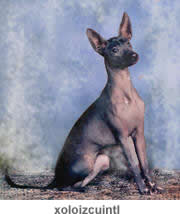bug tacos |
arts
|
dance | hairless dogs | textiles | stone tree | marriage | jade | trading |
ceramics | aztecs
 |
 |
| Book Store |
 Pets -- The only truly domesticated animals at the time of
the Conquest were dogs and turkeys. The hairless dog, known as xoloizcuintli,
was noted by Hernán Cortés in 1520.
Pets -- The only truly domesticated animals at the time of
the Conquest were dogs and turkeys. The hairless dog, known as xoloizcuintli,
was noted by Hernán Cortés in 1520.
It is one of very few dogs that is able to sweat through its skin, rather than pant. Today it is a most prized pet. This unusual breed is hairless. Xoloitzcuintli (pronounced Shollo-itz-quintli),or "shollo" for short.
Similar in appearance to a Pharaoh Hound, with a sleek body, almond-shaped eyes, large bat-like ears, and a long neck, the Xolo is notable for its dominant trait of hairlessness. The dominant hairless trait originated in this breed as a spontaneous mutation thousands of years ago.
Most litters contain both hairless and coated puppies. The hairless variety is completely hairless on the body. Some dogs exhibit a few short hairs on the top of the head, the toes and tip of the tail. Most hairless dogs are black or blue in color. About one out of every four puppies should be born coated.
History
The Xolo is native to Mexico, Central and South America and the Caribbean. Archeolgical evidence shows that the breed existed in the New World for more than 3,500 years. Most likely, early forerunners of the Xolo originated as spontaneous hairless mutations of indiginous New World dogs. Hairlessness may have offered a survival advantage in tropical regions. Their value in ancient Indian cultures is evidenced by their frequent appearance in the art and artifacts produced by the Colima, Aztec and Toltec civilizations in Mexico.
Xolos were considered sacred dogs by the Aztecs because they believed the dogs were needed by their masters’ souls to help them safely through the underworld. According to Aztec mythology, the god Xolotl made the Xoloitzcuintle from a sliver of the Bone of Life from which all man was made. Xolotl gave this gift to Man with the instruction to guard it with his life and in exchange it would guide Man through the dangers of Mictlan, the world of Death, towards the Evening Star in the Heavens. The Aztecs also raised the breed for their meat. 16th Century Spanish accounts tell of large numbers of dogs being served at banquets.[2]
When Columbus arrived in the Caribbean in 1492 his journal entries noted the presence of strange hairless dogs. Subsequently, Xolos were transported back to Europe.






